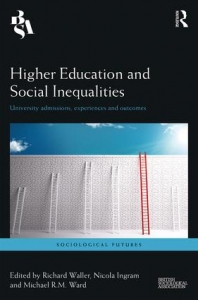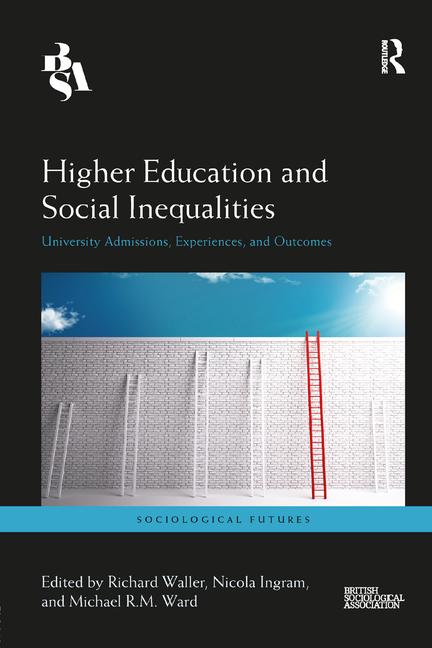Book Review: Higher Education and Social Inequalities
Higher Education and Social Inequalities: University Admissions, Experiences and Outcomes is part of the British Sociological Association’s Sociological Futures Series, which supports new and innovative theories, methods and approaches to sociological issues and debates and ‘the social’ in the twenty-first century. The book is an edited collection of research-informed chapters evidencing the ways through which higher education admissions, experiences and outcomes are influenced by wider social inequalities in society. Edited by Richard Waller, Nicola Ingram and Michael R. M. Ward, the book is organised into three distinct sections exploring interrelated domains: (1) higher education participation and social class; (2) higher education experience and social class; and (3) outcomes of university participation and social class. These are important because:
The issue of just who enjoys access to which university, and the experiences and outcomes of graduates from different institutions remain central to questions of social justice, notably higher education’s contribution to social mobility and to the reproduction of social inequality (xv).

This book is written at a time of mass higher education, where the participation rate has surpassed 50 percent, showing the appeal of university education to young people in the UK. Given this significant increase and rising tuition fees during this period, there has been an understandable focus on the extent to which higher education delivers the same participation, experience and outcomes for all students. This research has particular pertinence following the Widening Participation agenda, which has seen government and universities adopting measures to raise participation amongst non-traditional university students. Research in this area is now well developed, showing how an array of student characteristics are important in mediating ‘being a student,’ including social class, gender and ethnicity, amongst others, which are important explanatory characteristics in the three domains of this book.
The chapters throughout the volume provide an array of ways through which the relationship between higher education and social inequalities can manifest, from secondary data analysis of official statistics on student participation in higher education (Chapters Three and Four), to the embodied nature of social class identities (Chapter Eight) and how social class might be important in participating in internships after university (Chapter Eleven). Thus, the book is able to contribute to existing literature within the sociology of education, demonstrating that ‘class remains a fundamental and constitutive feature of what it means to become a student, to be a student and then to graduate’ (231).
In this review, two chapters exploring ‘getting in’ and ‘getting on’ in higher education are discussed: ‘How Meritocratic is Admission to Highly Selective UK Universities?’ by Vikki Boliver (Chapter Three); and ‘A Tale of Two Universities: Class Work in the Field of Higher Education’ by Diane Reay (Chapter Five).

The higher education system rests on the principle of meritocracy, with entry into the ‘top’ Russell Group universities supposedly the product of ability. This is despite growing attention to the over-representation of independent school students studying at the ‘top’ universities, with state school students and disadvantaged groups less likely to secure admission. The Russell Group claims that this pattern is a product of better grades attained by students from independent schools (41). It is this claim that Boliver investigates using Universities and Colleges Admissions Service administrative data. Despite a measure of social class being unavailable, the analysis conducted uses a range of measures of disadvantage to indicate whether a direct relationship exists between attainment and admission. This suggested that:
admission to Russell Group universities is not meritocratic in the narrow sense of admissions decisions being determined by achievement alone. On the contrary, it would appear that applicants from more socio-economically advantaged backgrounds are more likely to be offered places than applicants from less advantaged backgrounds with the same grades and facilitating subjects at A-level (45-46).
Irrespective of the need for further evidence in this area, what this chapter offers is an introductory assessment of the extent to which higher education is meritocratic, and thus problematizes explanations offered for the inequality in admissions to ‘top’ universities across the UK. Furthermore, this chapter lends support to current discussions surrounding the use of contextual admissions in higher education.
However, as Part Two of this book demonstrates, the role of social inequality in mediating higher education only begins at the admissions stage. Chapter Five, by Reay, focuses on ‘how working-class students manage the academic in relation to their social selves’ at two distinct forms of higher education institution: (1) an ‘elite’ Southern university; and (2) a Northern, post-1992 institution (84). One important theme running throughout this chapter is the interaction of social class with the institution. Adopting Pierre Bourdieu’s concept of field, an analysis of the higher education field is conducted, which indicates the positioning of each university in dominant and subordinated positions. This differential positioning translates into Southern students possessing differential access to ‘a rich distribution of different forms of capital, economic, social, cultural, and symbolic’ (86).
One way these capitals were found to benefit working-class students at Southern, as compared to Northern, universities was through the development of confidence and comfort in handling their learner identities. For Northern students, there was more of a sense of being ‘out of depth’ and doubt which characterized their learner identities. What differed between the two student groups was the level of prior academic success, which for Southern students enabled ‘a stronger congruence between the originary habitus […] and the logic of practice of the HE field’ to form (87-88). This meant that working-class students at the Southern university acted upon their academic challenges with more comfort and competitiveness rather than with anxiety. Reay is able to show the connection between ‘students’ prior learning experiences and dispositions [and] the dynamic interplay between these and the field of higher education’ (96).
It was therefore not only the social class background of students at the Northern university which created a very different university experience, but also the way their prior educational success granted access into an ‘elite’ area of the field of higher education, enabling the development of new dispositions and the strengthening of an academic learning identity. Key to this was differential access to learning support at each university, which is significant to the development of positive learner identities and was significantly lower at the Northern university, where those with more ‘fragile and unconfident learner identities’ were most likely located. Thus, it is not only the immediate university environment that is important to social class differentials in experiences nor is it social class background alone, but a complex interplay between student background, educational trajectory and institution that produces class-based university experiences in the UK.
What focusing on these two chapters in Higher Education and Social Inequalities has shown is how this collection contributes important research on the problematic relationship between higher education and social inequalities. Its adoption of innovative theoretical and methodological approaches enables different areas of the unequal university experience to be presented, ranging from structural patterns of inequality to the lived experience of inequality in higher education. In this way, it provides a warranted addition to the contemporary re-emergence of class analysis in the sociology of education and British sociology more broadly, and debates surrounding the future direction of higher education in the UK.

































































































